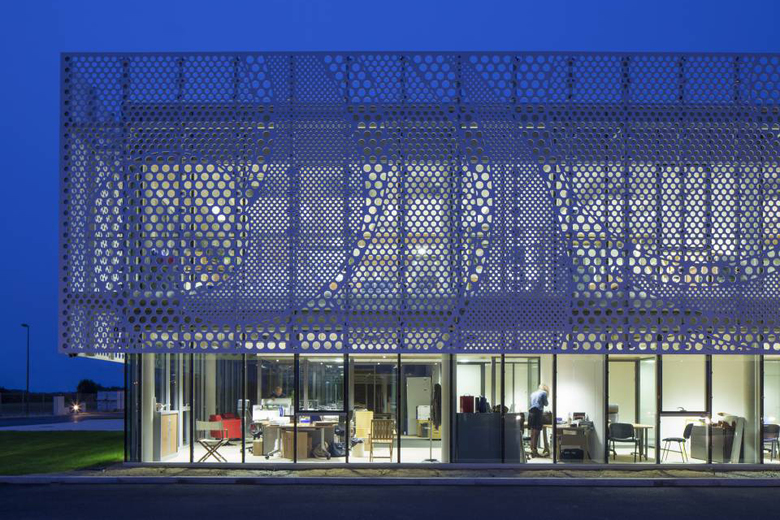HI-MACS® for Beneteau
John Hill
30. luglio 2014
Photo: Courtesy of LG Hausys
PAD Architectes' (Periot Architecture Durable) design for the headquarters of Beneteau in Givrand, France, is wrapped in a perforated facade made from HI-MACS acrylic stone.
Boat manufacturer Beneteau is celebrating its 130th anniversary this year, having been founded by Benjamin Bénéteau in 1884. Technology for boat design and building has changed considerably in that time. The company boasts, for example, that since 1991 "CAD and 3D modeling [Catia and Smarteam] enabled Beneteau to significantly reduce the building phases of prototypes." Further, on the manufacturing end, "since 2003, the prototype workshop is equipped with a 5 axis digitally controlled robot" that streamlines the production process. Combining the company's embrace of technology in design and fabrication with its reliance on a broad range of architects and designers, such as Philippe Starck, it's no wonder that their headquarters has a high-technology facade that artistically illustrates the company's business.
PAD's Frédéric Periot won a 2011 competition with a design that separates Beneteau's headquarters into two buildings – a predominantly solid rectangular bar on the north and a glass box on the south – linked by a walkway that bisects the Zen garden between the buildings. Wood clads the north building – reintroducing itself on the south in a cylinder that protrudes from the facade – while the south building's glass walls are screened by perforated panels made from HI-MACS in Alpine White. This southern facade showcases Beneteau's logo and cuts down on direct sunlight hitting the office spaces.
When it came time to select a material for the perforated screen, Beneteau's in-house contractor turned to LG Hausys' HI-MACS, having seen an installation of the thermoformable, multipurpose, ultra-resistant and non-porous acrylic stone in, appropriately enough, a shower in one of Beneteau's sailing yachts. One reason for selecting HI-MACS over other materials that can offer the same macro appearance is one micro detail: invisible fastening systems. Evident in the photo below and the detail at bottom, the panels overlap to create a subtle reveal but no visible screws, bolts or other fasteners. This detail helps to ensure not only that the architect's vision is maintained through construction, but that the office workers are not distracted by unsightly details as they peer through the screen to the landscape and sky beyond.
Articoli relazionati
-
Spotlight on Italy
on 16/05/18
-
Bologna Shoah Memorial
on 20/07/15






